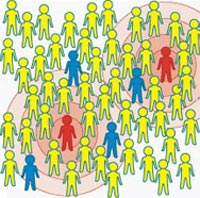- Go to http://fred.publichealth.
pitt.edu/measles
- Select “Get Started”
- Pick a state and city
- Play both simulations
To help the public better understand how measles can spread, a team of infectious disease computer modelers at the University of Pittsburgh has launched a free, mobile-friendly tool that lets users simulate measles outbreaks in cities across the country.
The tool is part of the Pitt team’s Framework for Reconstructing Epidemiological Dynamics, or FRED, that it previously developed to simulate flu epidemics. FRED is based on anonymized U.S. census data that captures demographic and geographic distributions of different communities. It also incorporates details about the simulated disease, such as how contagious it is.

In the simulations shown above, an outbreak begins with a single case of measles. On the left screen, colored dots representing measles cases quickly cover the area. On the right screen, only a few dots cluster around the initial case. The difference is the vaccination rate: 80 percent (left) vs. 95 percent (right) of school-aged children.
“The visualizations show the importance of a high vaccination rate in providing protection for the entire community,” says Ravi Ravichandran, one of our experts on modeling the spread of infectious diseases.

This concept is called community or “herd” immunity: Immunizing a large segment of a population against a contagious disease reduces the ability of that disease to spread. Last October, the U.S. Centers for Disease Control and Prevention published details about vaccination coverage among kindergartners for vaccine-preventable diseases ![]() . The coverage for measles varies by state, ranging from 81 to 99 percent.
. The coverage for measles varies by state, ranging from 81 to 99 percent.
Planned versions of FRED Measles will allow users to change vaccination rates and also to explore the effects of school closures on disease spread.
Pitt’s Donald Burke, who led the development of FRED, says that he hopes this “fact-based tool will help people understand the importance of immunization.”
FRED was funded in part by the National Institutes of Health under grant U54GM088491.

